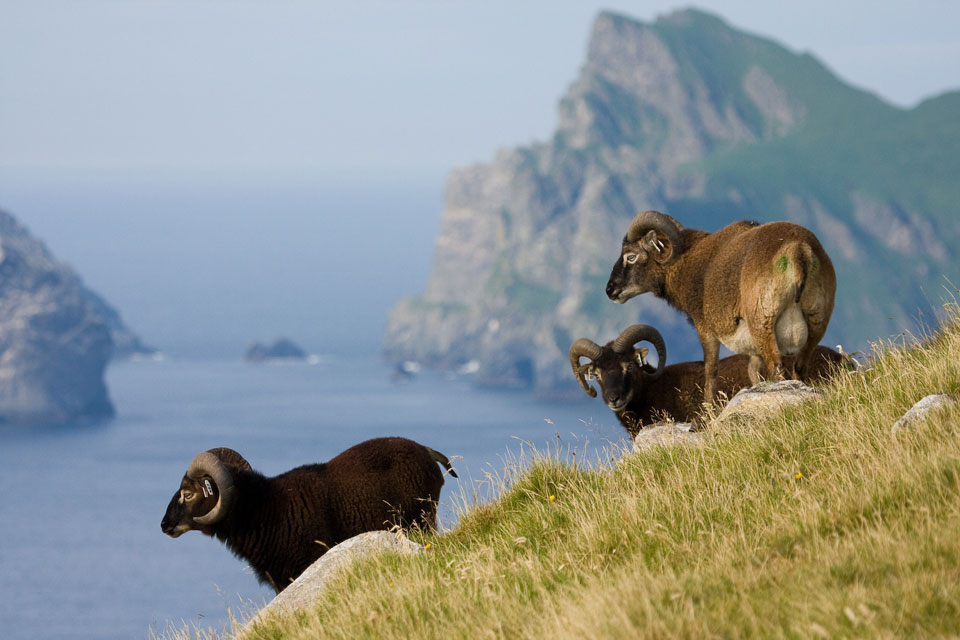St. Kilda is a small group of islands far off the West Coast of the Outer Hebrides. Inhabited for at least four millennia it has a rich medieval past.
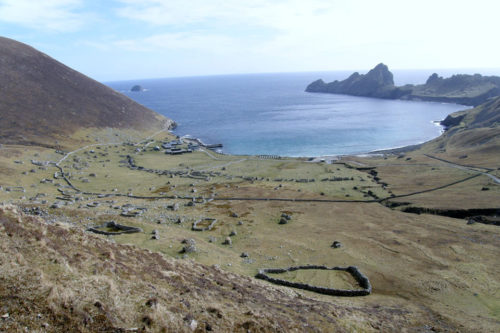
Wild, isolated and remote! Why would people in the earlier Neolithic period row or drift more than 70 km out west of the Outer Hebrides in order to settle on these wild and inhospitable islands? And how did the first sheep arrive? These questions are in reality unanswerable. What we do know, though, is that remains of people have been found reaching back more than 4000 years. We also know, that Early Medieval – Celtic – Christians inhabited the islands in the 6th – 8th century. Although difficult to date the cairns, the stone formations, and the remains of the village, at least three ancient chapels have been located at Village Bay, two of which were named after the early Christian missionary saints, Columba and Brendan. In modern times, three early medieval stone-slabs with crosses have been discovered reused as building-material in a19th-century house.
However, studying the place-names it soon becomes obvious that they are of Scandinavian origin witnessing to the fact that a Viking population must have colonised the islands as part of the general move into the wider North Atlantic; whether seasonal or permanent is not known. However, from the 13th century, a permanent population has been recorded. Even though a small-pox epidemic nearly wiped out the population in the beginning of the 18th century followed by a repopulation of Gaelic-speaking people from Harris and Lewis, these place-names did not shift. But then, the archipelago of St. Kilda obviously belonged to the orbit of the seafaring Norsemen. The first time, the islands are mentioned is in AD 1202 when an Icelandic clergyman named Gudmundur Arason was blown off-course while sailing to Norway. Luckily the crewmen seem to have been competent and the ship sought shelter in Village Bay in July 1202. At that time the place was called Hirtir (Hirta) meaning herd – perhaps referring to the wild-roaming herds of sheep. Perhaps the future Icelandic bishop was served mutton stew and perhaps even skyr.
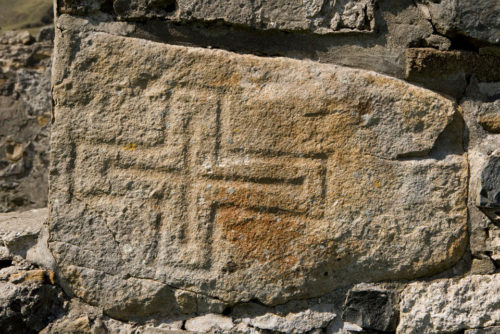
The remains of the medieval village, where he stayed, can still be seen. It lies near Tobar Childa at the foot of the slopes of Conachair. Altogether, there were between 25 to 30 houses, indicating a population of perhaps 125 – 150 people. Most were black-houses of the typical Hebridean design, though some were turfed and not thatched. This village was first abandoned in 1834 when a new village was erected of drystone and turf further down the slope.
One of the reasons behind this continued habitation is that the islands possessed a rich combination of resources – 30 ha sheltered arable land (growing barley), seals, extensive sea-bird colonies and a semi-feral population of sheep provided a rich subsistence. This was a valuable piece of property and the population had ample opportunity to live out the same kind of life as that which characterised the Outer Hebrides. It is estimated that the islands today host 5/6 of the gannets in the Hebrides as well as 3/5 of the puffins. Gannets and their eggs were great delicacies and an important export article way into the 20th century. As such, these birds provided an income which could be used to pay taxes and procure goods from the mainland.
Nevertheless, all this had an end. In 1852 a third of the population emigrated to Australia. This left the remaining population crippled and in August 1930 the 36 remaining inhabitants took ship for the mainland. Since then, the islands have been designated World Heritage and
Soay Sheep
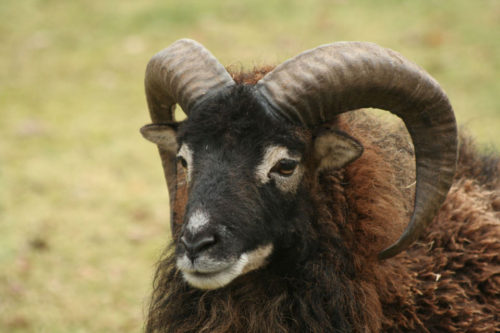
Special interest is linked to the sheep at St. Kilda, which are called Soay sheep. Mature females weigh no more than 24kg, while mature males can weigh up to 38kg making them about one third the size of most modern domestic sheep. It is estimated that there were at all times between 1500 and 2000 of these animals, which belonged to the Lordship of the Isles, the MacLeods of Dunvegan, lairds from1498 until 1930. This primitive, native breed is considered to be a direct descendant of the moufflon found in Sardinia and Corsica.
The flocks of sheep were central to the survival of the people on Hirta and the neighbouring islands of Soay and Boreray, providing wool, skin, milk and meat. On St. Kilda, the sheep were in the later period of a Hebridean variety of the Scottish Dunface, a primitive sheep probably similar to those kept throughout Britain during the Iron Age. But on Soay and partly Boreray the animals belonged to the ancient breed, basically living out their lives as wild animals. When the last 38 people of St. Kilda were evacuated from the islands in 1930, the government took over 1300 animals from the main island, while the semi-feral sheep on Soay and Boreray were left behind.
It is told that in 1889 the Islanders made three trips to Boreray. In the spring, they went to collect eggs and count the sheep. In June they went to Boreray to take the wool from the sheep. Finally, in early autumn they went to kill the young gannets. The wool from the Soay sheep is reasonably easy to get at as it shed it on its own. The wool only has to be gently pulled from the animal, which is naturally moulting. There is also ample evidence that the meat of mutton, birds and seals were part of the diet. The meat from gannets and sheep were stored in cleits, which can still be seen around the islands. Such cleits were loosely constructed stone stores designed to allow the meat to dry in a very damp climate. Over 1400 can be found on the islands.
Beginning in 1952 the population of sheep at Hirta garnered new attention. Ecologists discovered that they had a rather unusual population dynamics, alternating between reaching maxima and then crashing. They also found that the colours, horns and other characteristics varied widely. Today, the sheep are the object of a series of intensive research projects focusing on genetics, evolution, ecology, parasites and immunology as well as ageing. One of the fascinating questions has been why the average Soay sheep on the island of St Kilda (Scotland) has been decreasing and getting lighter in the colour
The Soay and Boreray Sheep Society organises the conservation and breeding of the two races – the Soay and the Boreray, the descendants of the sheep, which the St. Kildans kept as domesticated animals on Boreray (and which were left at the evacuation).
Going Medieval on a Farm in Virginia Piedmont
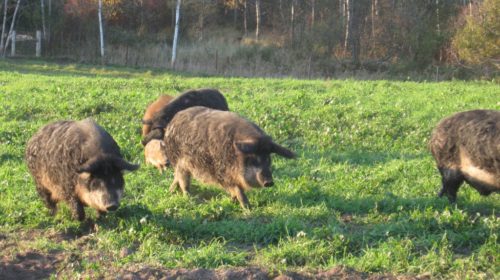
Recently the Soay sheep have found a new role as ecologically important animals at a farm bent on restoring top-soil, the ecological way.
Depleted soil is one of the curses of modern intensive farming. Soil erosion, climate change, and general depletion are scourges contributing to a slow crisis in global food production. Another source is chemical fertilization, which often suffocates aquatic life and creates dead zones in coastal margins. As opposed to this manure from animals help reconstruct the soil by not only fertilizing but also adding essential carbon to the land. One of the more elegant ways of doing this is setting up your farm with animals, which can eat off the stubble and root in the dirt.
A particular interesting experiment has been carried out by Andrea Chandler, working on her 2.5-acre ‘manor’ in Virginia. In 2008 she discovered that the two back acres had literally no top-soil. Her neighbour could tell her that the former owner had not only cleared the land of mature oaks but also scraped off and sold the top-soil.
In order to rectify this, she turned to the medieval practice of ‘faldage’ dividing the blighted grassland into three ‘folds’, or fenced pieces of land. Here she had a mixed flock of goats, sheep and pigs ruminate during winter. The goats were for clearing the land of shrubbery, the sheep for grazing on the stubble and the pigs for rooting the manure into the ground. Every week or so, she would roll a bail of hay into a new spot in the folds, feeding the animals.
For the sheep, she chose the tiny Scottish Soays, which – because they are lightweight – do not compress the soil to the extent that modern breeds do.
Ever so slowly this project resulted in a growing layer of top-soil. Andrea Chandler estimates that the animals can build 3-4 inches in the areas where they hay bales are located simply be feeding at their hearts’ delight. By adding the rooting pigs, the manure – which she calls ‘organic soup’ – is slowly churned underground, creating a piece of healthy land out of the former desert of weeds and shrubbery. By carefully rotating the animals from one patch to the next, the land, she tells us, has been recovering to the extent that it may now be planted ‘with a mix of grasses, legumes, and broad-leaf weeds with deep tap roots to preserve the new soil, fix the new nitrogen, and bring up nutrients from the clay subsoil’. This, in turn, helps to pay the bill to feed the animals.
World Heritage
In 1956 the Archipelago of St. Kilda was bequeathed to the National Trust for Scotland and in 1986 it was designated World Heritage (the first in Scotland). Designated as a mixed – both natural and cultural – heritage, it is carefully guarded against unsustainable tourism and the threat of invasive species – makes it a complicated venue to run for the Trust.
SOURCES:
The Manor of Mixed Blessings by Andrea Chandler
St. Kilda. A Comparative Analysis of the Cultural Landscape
Document prepared in 2004 to clarify the Unique Cultural heritage is the Archipelago.

By Tom Steel.
Harper Collins 1975
St Kilda and the Wider World: Tales of an Iconic Island
by Andrew Fleming (Author)
Windgather Press 2005
ISBN-10: 1905119003
ISBN-13: 978-1905119004
St. Kilda: A people’s History
By Roger Hutchinson
World Heritage Site:
VISIT:
St. Kilda – World Heritage Site
St. Kilda – National Trust for Scotland
HEAR MORE:
FEATURED PHOTO:
Sheep on the Island of Soyas in St. Kilda’s archipelago. © 2016 – The Shrinking Sheep of St Kilda
